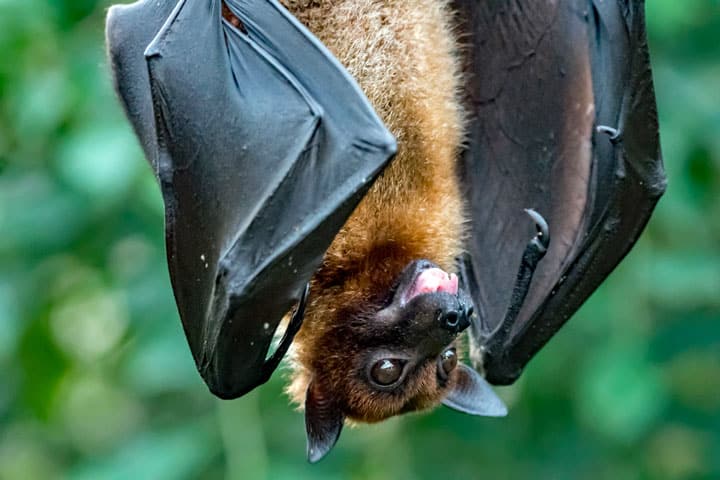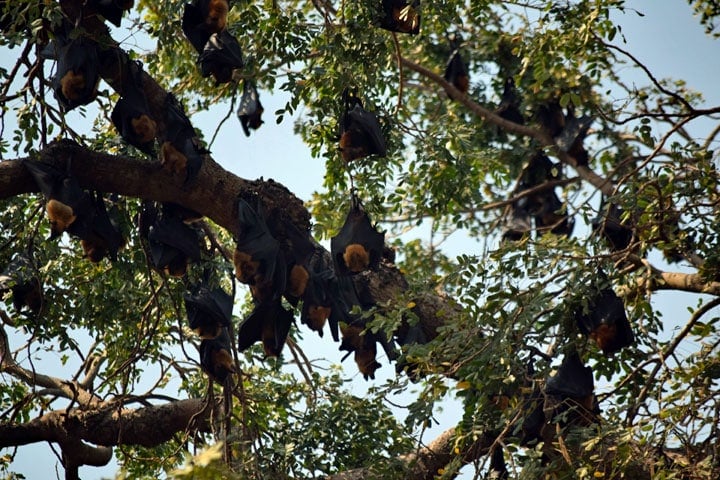Bats

Bats in Thailand
You could call it the 'Miracle of Kao Kaeo', the millions of bats that fly out at dusk in a continuous long wide path for their daily food. In untold numbers they inhabit the caves of the chalk cliffs of Khao Kaeo, located within Amphoe Banphot Phisai, about 40 kilometers north of Nakhon Sawan.
Very large numbers of bats fly out just after six every day. For more than an hour you can see the bats leave their hiding places in a continuous wide string. They are an innumerable number, and looking at the long continuous wide track in which they move gracefully in the same direction, they must undoubtedly number several million by a conservative estimate.
The above text was published on Thailandblog on January 5, 2016 in my story 'Millions of bats and thousands of monkeys'. Many times in my travels through Asia I have seen these strange, mostly tree-hanging bats, but the memory of Khao Kaeo remains indelible in my memory.
My knowledge about bats is nil until I very recently got into a conversation with Frans Hijnen, secretary of Stichting Stadsnatuur Eindhoven, ornithologist and idol of bats about which he really knows everything. Go share his story.
The bat does not exist. There are more than a thousand bat species worldwide, of which 17 species occur in the Netherlands. The largest bat in the Netherlands, the eared bat, is no longer than eight centimeters. The smallest Dutch bat, the pipistrelle, fits in a matchbox and weighs as much as a sugar cube. Bats can get quite old; over twenty years is no exception. A bat's body is adapted to hang upside down. When the animals hang with their heads down, the body weight pulls on a tendon, which pulls the legs together. Actually, they don't need any muscle power to stick around. Hanging upside down therefore costs no energy. Due to an adapted circulatory system, the blood does not flow to the head.
Bats are not birds, nor are they flying mice. They are a separate group of mammals, the only mammals that can actually fly. They fly with their hands. They have very long fingers with a thin (fly) skin in between, which in most species extends through the hind legs to the tip of the tail. Bats are therefore also called hand-winged or with a nice word Chiroptera. They live in places that we usually cannot reach, such as in the cavity wall or under the roof tiles. Some bats, such as the noctule bat and the water bat, live in tree cavities (e.g. abandoned woodpecker holes) during the summer. Typical species that live in buildings are the serotine bat and the pipistrelle.
Because the arms and legs are completely adapted for flight, bats cannot make their own nest, cut a hole in a tree or dig a hole. Bats are therefore completely dependent on existing conditions for their habitats. This does not prevent bats from using a wide variety of habitats. They often use a separate place for every possible weather condition and for every season.

The gray long-eared bat (Plecotus austriacus) is a fairly large European bat
All bats in the Netherlands (and in Europe) feed on insects. Some species also eat a relatively large amount of spiders and the lake bat sometimes even fish larvae. To stay alive, bats have to catch a quarter to half their body weight in insects. On a warm evening, a bat can pluck hundreds of mosquitoes, moths and beetles from the air. A group of bats eat kilos of insects in the summer. Some bat species prefer moths or beetles.
Watch with your ears
Bats have eyes that allow them to see very well in twilight. But to find food in the dark, most bats use their voice and ears (sonar or echolocation). A bat continuously emits short sounds for this purpose. With their very sensitive ears, they can use the echo to hear what the environment looks like and where the insects are. These sounds are so high that most people cannot hear them. Some moths can also hear the sounds of bats well and try to flee. To surprise and eat them, the long-eared bat flies around whispering. And to still hear echoes you need very large ears. Those of the long-eared bat are as long as the body! However, the Asian bat is much larger than its European counterpart.

Fruit bat
Most large bats belong to the Megachiroptera (today usually called Pteropodidae). There are 166 known species worldwide. They are also called flying dogs or kalongs. This group consists mainly of large species. The largest has a wingspan of 1,70 meters and weighs almost a kilo. These bats have large eyes and find their way in the dark by sight rather than sound like most other species. Most live on fruit, some also on pollen and nectar. This bat is found in Thailand and throughout Asia; but also in Africa, Australia and on some islands of Oceania.
Almost everyone has seen a bat at some point. At dusk they come out to chase mosquitoes and moths like true aerial acrobats. For some people a fascinating scene, for others a real nightmare. Bats evoke unpleasant thoughts in many people. For example, bats would fly into your hair and attack you to suck blood and they would spread all kinds of diseases. The saying 'unknown, unloved' certainly applies to bats. Few people realize that bats are very special animals and occupy an important place in nature.

Fruit bats
Corona
The question cannot be left out at this time: are bats also infected with the corona virus? Answer: No, the new coronavirus has not been found in bats in the Netherlands, despite the fact that bats in the Netherlands have been extensively examined for viruses in recent years. Based on genetic research, the new coronavirus is most similar to coronaviruses found in an Asian species of horseshoe-nosed bat (Rhinolophus affinis). This bat species is widespread in South and Southeast Asia, but not in Europe. Bats from South and Southeast Asia are also not in contact with bat populations in Europe. But living in Thailand I would stay away just to be on the safe side and let them take a nice nap high up in the trees.



Bats are protected in the Netherlands. That goes a long way. If they are in buildings, they may not be demolished or rebuilt.
Greetings Freek Vermolen
Nice anecdote about bats:
I then stayed in a hotel in the center of HuaHin. I stood on my room terrace every evening watching the fall of darkness and the beginning of the stream of tourists who flocked to the Chaolay seafood restaurant. On the room terrace next to mine I sometimes got talking to an older Austrian lady. For two evenings already she suddenly called out to me: “Shau mal, Johannes est wieder da.” And then each time: “Hello Johannes, alles gutes?” And just wave in the air. I didn't understand anything and kept staring at the parking lot below where Johannes could be. At first I thought that lady was a bit confused, until I asked who she meant on the third day.
It was a lone flying bat that she observed every night. Apparently she was thinking of the comic operetta Die Fledermaus by Johannes Sebastian Strauss. The following days I waited with her for Johannes to flutter by. With pleasure!